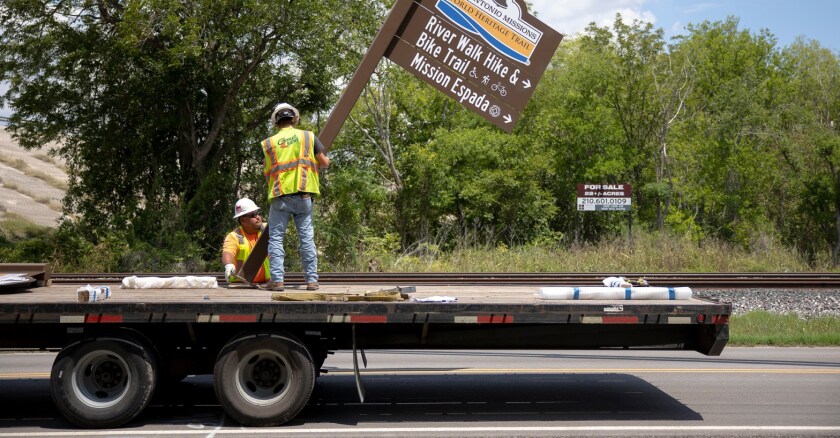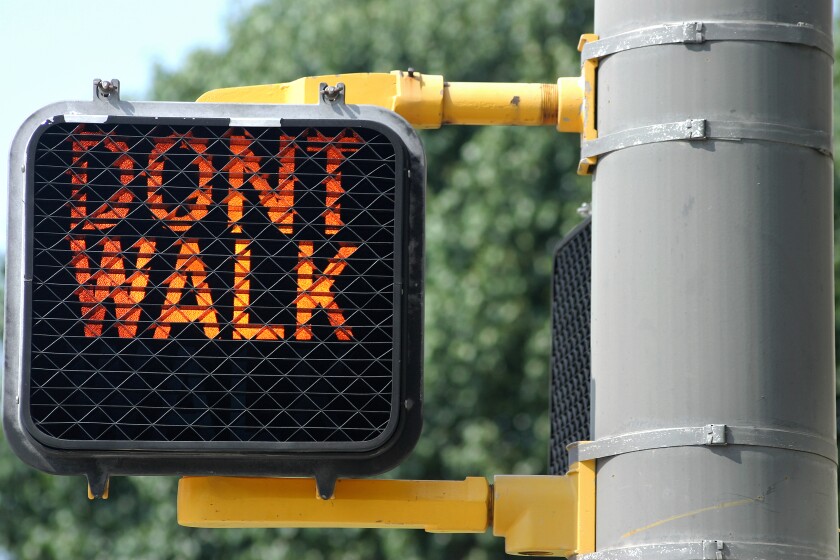Nickas was born in San Antonio but left when she was a baby. She grew up in southern Indiana near the Ohio River, and moved back to Texas in 2013, she says, like a salmon returning instinctively to its spawning grounds. She used a bike to discover the sprawling city. But she admits it’s not the friendliest place for less die-hard bikers, because of the heat, the low-density spread of neighborhoods outside of downtown — and because the streets themselves are hostile.
“All the streets of San Antonio feel unsafe,” she says. “At no point have I felt safe riding on the streets on my bike here.”
Around the country, more pedestrians and bikers are being killed and seriously injured by drivers. It’s true in Texas, which has one of the highest rates of traffic deaths overall and has seen recent spikes in pedestrian deaths. And it’s true in San Antonio, where pedestrian deaths have been on the rise for four straight years.
San Antonio's Incomplete Streets
Like a lot of other big cities, San Antonio has tried to make some of its streets safer for bikers and pedestrians. In 2017, voters approved a bond measure to fund a range of public-realm improvements, including 200 miles of new sidewalks. Among the projects funded in the bond was a “complete street” redesign for a two-mile stretch of Broadway, a north-south arterial with three vehicle lanes in each direction. The Department of Public Works spent parts of the last four years planning the project, holding community-engagement meetings and designing the flow of traffic. Its final design called for two of the six driving lanes to be converted to protected bike lanes — one in each direction — with wider sidewalks, new street trees and other safety improvements.
But earlier this year, the Texas Department of Transportation put the brakes on the plan. Broadway was actually State Loop 368, the department said, and no lane reductions would be allowed. This caught local officials off guard. Years prior, even before the bond referendum in San Antonio, TxDOT had initiated a “turnback program” meant to let cities take control of state roads that the department no longer wanted to maintain. Broadway was one of those roads. Not only that, says David McBeth, assistant city engineer for the Public Works Department, but the city had actually had meetings with TxDOT about the project over the years, and was proceeding on the understanding that the road would be returned to city ownership once a project was complete.
“We had been working with TxDOT since 2016, when the initial concepts for Broadway were being developed,” McBeth says. “This sudden shift to say that the plan we did — working hand in hand with TxDOT — was no longer going to be possible was pretty surprising to us.”
The department’s opposition to the Broadway project isn’t a one-off intervention, but part of a broader policy of maintaining all current vehicle lanes on all TxDOT roads all around the state. Last month, San Antonio Report stated that TxDOT would oppose another planned street improvement project on Roosevelt Avenue in San Antonio as well. It is supporting another project in neighboring Alamo Heights after local leaders there agreed not to convert any traffic lanes.
The moves are in keeping with state leaders’ focus on reducing traffic congestion on state roads, and part of a broader culture war over transportation. The Texas Republican Party’s 2022 platform explicitly calls out “road diets” that reduce automobile lanes as “anti-car measures that punish those who choose to travel alone in their own personal vehicle” and calls on the state “to protect drivers from these California-style, anti-driver policies in Texas.” Texas Gov. Greg Abbott announced an $85 billion transportation plan late last month, with the stated goal of “preserving roadways for Texas drivers.”
The city and state have completed dueling traffic studies for Broadway Street in San Antonio. The city’s study suggests that with certain intersection improvements, traffic flow could be maintained or even improved with one less lane for cars in each direction. TxDOT’s study makes a different conclusion. The department declined to make someone available for an interview, but sent a statement in response to emailed questions.
“Results from the most recent traffic studies show that population growth in the area necessitates this capacity, even with optimistic assumptions about future travel behavior shifting to other roadways or alternative modes of transportation,” an agency spokesperson said in the statement. “The implementation of a reduced capacity design is counter to TxDOT’s focus on addressing congestion not only in San Antonio but throughout the state of Texas and therefore, inconsistent with the operational objectives for this busy state-owned roadway.”
Engineering Conservatism
One reason why the U.S. sees so many traffic deaths is that national vehicle design standards and street design standards prioritize driver speed and convenience over other roadway users, says Sara Bronin, a professor of city planning in the Cornell School of Art, Architecture and Planning. Those standards are slow to change, and the norms of the engineering profession prioritize existing practices — even amid mounting evidence of traffic violence and long-running doubts about how well new road-building actually accomplishes the goals of moving people more quickly. Some groups, like the National Association of City Transportation Officials, have pushed for more holistic urban design guidelines, but highway engineers tend to stick with level of service for vehicles as their North Star, Bronin says.
“Professional engineers are conservative by nature, because what an engineer should ideally do is rely on proven safety standards,” she says. “What we’re seeing in the traffic context is that the inclination to rely on established safety standards has resulted in complacency, and that has led to these standards not being questioned by the majority of decision-makers.”
It’s not unusual for bike lanes and other street improvement projects to be controversial. But opposition to those types of projects is most often hyperlocalized, with neighboring residents or businesses opposed to changes they believe will interfere with traffic flow or parking. In Texas, the state is holding up plans that have already gotten substantial community buy-in and voter-approved funding.
The Broadway project is now in a type of limbo, says McBeth, the assistant city engineer. TxDOT says it will support some improvements on the street as long as they don’t involve lane reductions, and that it would also support new bike-lane projects on other city-owned streets. McBeth fears the city “may lose some trust with the public” if it’s unable to complete a street-improvement project that has been so long planned. But unless TxDOT agrees to release the road, or change its stance, it’s not clear how the project could move ahead.
“We just don’t agree at this point,” McBeth says. “It’s a different philosophy.”
Related Articles













